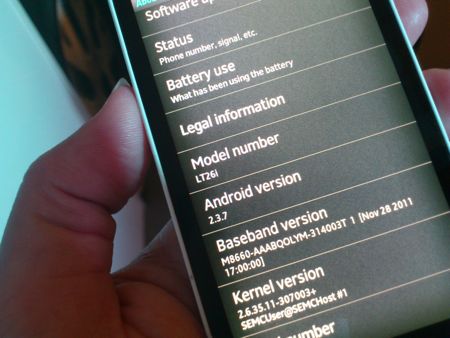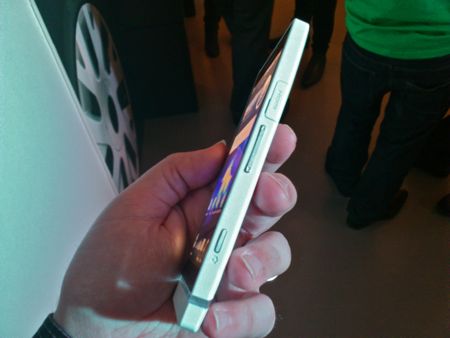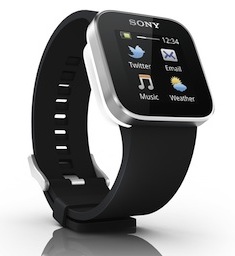Hands-on with the Sony Xperia S, including a peek at NFC SmartTags and SmartWatch
To the galaxy and beyond

Sony's latest Xperia phone is gunning after Samsung's amazing Galaxy Nexus, and with a camera that offers more than double the amount of pixels, it has a pretty good chance. In fact, thanks to its camera and a few other clever features, it could be set to become the best Android Ice Cream Sandwich smartphone on the market.
However, there is a catch – and rather a big one. Sony's new smartphone won't actually ship with the latest Android OS installed from day one. Instead, an update will follow a short time after its launch, set for March. Given there a number of changes to the look and feel of Android Ice Cream Sandwich over Gingerbread (the Xperia S comes with 2.3.7 installed), some consumers might find the change quite confusing.


But, the old version of Android is only a short-term problem, so let's get back to the good stuff! Besides upping the camera to a mighty 12-megapixels, the processing power has also been given a mighty boost over single-core 1GHz processors used throughout 2011. The dual-core 1.5GHz processor really flies, and the Xperia S seemed even more nimble than the Galaxy Nexus. Given how quick and smooth Samsung's handset is, that's quite amazing achievement.
Like the Xperia arc and arc S, thescreen on the Xperia S is extremely bright. The 4.3-inch, 1280x720 pixel, display shows vibrant images and sharp text, which was demonstrated perfectly when I was shown a clip from the animated film Cloudy with the Chance of Meatballs (is this the new Monsters Inc test?). The only surprise (although less so for anyone with an existing Xperia smartphone) is the lack of an auto brightness setting on the phone. Keeping the phone on the brightest setting will be tempting, but it will come at the expense of battery life.
Besides the amazing visuals, there's also a pretty decent speaker inside too. Certainly a lot meatier than the one fitted inside the arc. For the best playback experience, the phone has an HDMI output. When connected to a TV, the phone switches to a unique carousel interface to manage media, as against merely mirroring the phone display – although I wasn't able to actually see this in action.
Gamers will be pleased to know that the Xperia S is a PlayStation Certified device, although the exact details of its gaming potential will become known nearer to the release date. With HD graphics and the hook-up of your wireless controller, it's fair to assume the experience will be pretty good.
Like the Galaxy Nexus, there's no memory card slot. You'll get 32GB and that's it. Google argues that there's a good reason for this, as it allows more dynamic usage of the storage space. Instead of partitions that previously resulted in just 380MB being put aside for apps on the 2011 Xperia models, the space can be shared around freely. It also stops the risk of losing data when apps are installed on a memory card that is subsequently removed, as well as allowing data to be accessed from a computer at the same time as from the device. Yet, great as all of that is, I still like being able to upgrade storage space!
 Design
Design
In the original photos from its launch at CES, I feared the Xperia S would look like a rather dull rectangular box with harsh edges, but in the flesh it's more curved than I expected. It isn't quite as striking as the arc, but that's a personal opinion.
The transparent bar along the bottom is actually the antenna, and I can imagine Sony making a big deal of this when the advertising begins. In our basement location, Sony staff were quite keen to show more signal bars on the Xperia S than other handsets – but don't consider that to be an authoritative test!


Inside the transparent bar are three Android button icons that appear when lit, but it's the three small dots above where you'll find the touch-sensitive buttons you actually press. You'll be seeing the same transparent feature on a number of Xperia smartphones released in 2012.
Sony didn't appear to have made any changes to the Sony Ericsson home screen, but that is probably due to the fact that the real changes will come from the update to the new OS.
CameraIt wasn't long ago when Nokia, Samsung and Sony Ericsson each had 12-megapixel cameraphones on the market. But then everything dropped back to eight and five megapixels, marking a rather odd step backwards and without any explanation. The most likely reason was the rush to make handsets as slim as possible, which rendered the 12-megapixel handsets obsolete because all of them were accompanied by a chunky Xenon flash.



With the improvements to image sensors and LED lighting, Sony has opted to try again and go without a Xenon flash. With the Exmor R sensor, offering better low-light image capture, and brighter LED lighting, it should be possible to get excellent indoor shots. Yet, that isn't the bit that impressed me most.
Microsoft has already made it a requirement that every Windows Phone device must have a dedicated camera button and activate even from standby mode, but Sony has improved the activation time to start up in just 1.5 seconds. I am sure it could be quicker still, but the delay is to ensure the camera isn't started by mistake. Taking extra pictures is incredibly fast too, with a shot-to-shot of well under a second.
If you consider a camera to be a vital addition to a smartphone, this one simple feature could be what convinces you to buy it as it makes the camera far more usable than pretty much any other phone (Windows Phone models being about the only exception). Of course, image quality is important too – so we'll be checking this out thoroughly (and its HD video recording ability) when we get our review model in March.
NFC (Near Field Communication) is a feature that has been included in a few handsets already, such as the BlackBerry Bold 9900, the Samsung Galaxy Nexus (and the older Nexus S) and a few Nokia handsets running Symbian, but so far it hasn't really been used for anything useful. With Google Wallet still not quite ready for a proper launch, and smart tags at bus stops and in shops more of a novelty, Sony has actually come up with something to make NFC do something good right now.
Either included with the phone, or sold separately (that will depend on the networks and retailers), you can use 'SmartTags' to make your phone perform preselected tasks when touched against the phone. Up to four tags can be set up, each colour coded, and positioned wherever you want – such as by your bed, in a car or by the front door. You then decide what each tag, when tapped, will make the phone do.
Examples might include turning off the ringer and starting the alarm clock when you go to bed, or turning up the screen brightness, activating Bluetooth and firing up Google Navigation when you jump in the car. You can launch apps, change profiles and pretty much anything else.
Even Smarter
What's more, Sony has a collection of cool 'smart' accessories like the Smart Wireless Headset pro, which works as a Bluetooth stereo headset when connected to a phone (including a display for reading text messages, checking on incoming callers and calendar notifications) and a standalone radio and music player when disconnected, thanks to its own memory card slot.

There's also a replacement to the LiveView, which never really set the world alight but was quite a clever concept. The SmartWatch adds a capacitive touchscreen, with multi-touch, and allows you to see incoming calls, control the camera, read social networking feeds and much more (more features come by downloading new plug-ins via Android Market).
At £100, it's a perfect geeky gift idea. What's more, you don't need a Sony or Sony Ericsson handset to use the SmartWatch, as the software is available to most other Android smartphones and tablets too.
ConclusionAll in all, the Xperia S is an exciting new product. Even with loads of new devices being announced at Mobile World Congress next month, it should easily be able to hold its own.
If the Xperia S had been made by Apple, this would have been it for 2012, but Sony has in fact got more devices to show off next month. However, the Xperia S is the flagship and it's hard to imagine a better start for Sony as a powerful 'new' player, following the ending of the joint venture with Ericsson that should be completed by early February.
VideosI also got to capture some presentations from the recent Sony trade event, showing off the quick start-up time of the Xperia S and the SmartTags in operation. There's also a demo of the SmartWatch.


